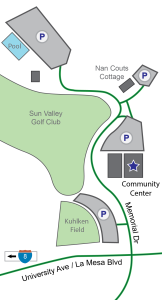May 2016
Honoring Yesterday – Protecting Tomorrow
Vol. 47, No. 5
What’s Inside
- President’s Message
- Recent Events
- City Retirement Crisis Continues
- The Role of a RESDC Board Director
- Volunteers of the Quarter
- Bits and Pieces
- A Special Message from the President
- Follow RESDC to Stay Informed
- Board Member Profile
- Pension Facts
- Flag Day Luncheon
- Public Retirement Seminar
- Welcome New Members
- In Memoriam
May Calendar of Events
Thurs., May 5, 9:30am
RESDC Board of Directors Meeting
8825 Aero Drive, Suite 205
Tues.-Fri., May 10-13
SACRS Conference, Costa Mesa
Thurs., May 19, 8:30am
SDCERA Board of Retirement Meeting
2275 Rio Bonito Way, Suite 200
Mon., May 30
Memorial Day
RESDC Office and SDCERA Office closed
President’s Message
By John J. McTighe 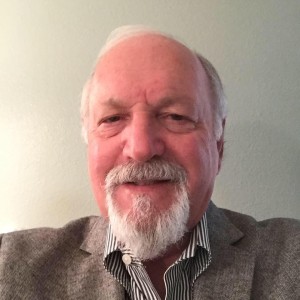
“Aging in Place.” What does that mean to you? The popular Wikipedia online encyclopedia quotes the Center for Disease Control’s definition as “the ability to live in one’s own home and community safely, independently, and comfortably, regardless of age, income, or ability level.” Over the past few months I’ve become very familiar with one aspect of aging in place. Hopefully, some of you might benefit from reading about my recent experience putting aging in place into practice.
In 1975, my wife and I purchased a house while it was still under construction and moved in with our two little girls a few months later. It was the perfect home for our family in a good location in a nice community with convenient freeway access. We saw our daughters grow up in that house and have many good memories of family get-togethers and other activities there. In a word, we were comfortable in our home, except for one thing, the master bedroom is on the second floor. As we grow older, it’s not as easy as it used to be to climb those stairs several times a day.
So, a few years ago we started the thought process of where we would live out the rest of our “golden years.” Our thought was that a single story house with a nice master suite, a spare bedroom for when the grandkids visit, and an office/den would be ideal. In essence, we’d downsize from our four bedroom house to a three bedroom house. So that’s what we started to look for. We didn’t want to move too far from where we lived because, well, we were comfortable there. Needless to say, we were shocked to find that there were not too many houses that met our desires and those that were there were way more expensive than we were willing to pay to “downsize.” Add to that the cost of fixing up our house to sell and the cost of commissions to sell and buy a new house and we’d have a lot more expense to incur in the process.
After recovering from the sticker shock, we began to think about whether there was any way our home could be remodeled so that we could live in it “safely, independently, and comfortably, regardless of age” as the CDC definition states. There was one small bedroom downstairs that had always been used as an office/den. Between it and the family room was a full bathroom with a combination tub & shower. We thought that perhaps the bedroom and bathroom could be expanded to make a combination of a mini-master suite and office. Fortunately, there was room to the side of our house that could be expanded into, so space was not a constraint.
Once we had the idea of what we wanted to do, the next question was where do we start? We started by attending a “home show” at the Convention Center to get ideas. We saw a lot of flooring, tile, roofing, siding, bathroom contractors, and met several remodeling and design/build contractors. We selected two of the latter contractors to enter into discussions with. The one constant in our discussions with these contractors was that, to the extent possible, entrances, doorways and the shower should be sized so that should we ever get to the point of using a walker or a wheelchair we could access the room and shower. After several iterations, both contractors gave us an order of magnitude cost estimate on the same design concept. We had sticker shock again. After having watched so many HGTV remodel shows we were pretty sure we knew what the cost should be. Wrong! Both contractors were in the same cost neighborhood, so we had a fairly good comfort level that they were not trying to take advantage of us. This required that we do some serious reconsideration of whether we wanted to do this and how we would pay for it. We talked to a number of people and we prayed about whether to go forward with this project. After we were convinced this was the right thing for us to do at this stage in our lives, we selected one of the contractors with whom we felt most comfortable.
Next month, I’ll finish my saga and provide some tips on how to survive a remodeling project in your home. In addition, we’ll include some before and after photos to illustrate the results.
Recent Events
- RESDC recently participated in the bi-annual Retirement Security Roundtable meeting. Over 30 public employee retiree association representatives explored areas for collaboration and coordination of advocacy efforts with a goal of protecting the benefits many public employees contribute to!
- SDCERA Board of Retirement approves 1.5% – 3% COLAs for retirees, effective April 2016. For more details visit: www.sdcera.org/retired_cola.htm.
- California has moved closer to becoming the first state to make retirement savings accounts a near-universal benefit for workers. A state board sent a set of recommendations to the Legislature calling for the creation of the California Secure Choice Retirement Plan – essentially a 401(k) plan operated by the state and open to private-sector workers whose employers don’t offer a retirement savings plan.
City Retirement Crisis Continues
By Stan Coombs
The San Diego City Employees Retirement System seems unable to pull itself free from controversy. In response to a recent California Public Employment Relations Board (PERB) ruling, that negated the City’s 2012 Proposition B, and required reinstatement of defined benefits for employees, the City Council unanimously voted to appeal.
This city retirement battle can be traced back more than 14 years. Legal costs must total in the millions!
In late 2002, a member of the City Board of Retirement, Diann Shipione, tried unsuccessfully to convince other Board members they weren’t living up to their fiduciary responsibility by allowing the City to contribute less to the retirement system then was required under the City Charter. The next year, Shipione announced that a city bond sale prospectus hadn’t properly disclosed all city pension fund liabilities. The Securities and Exchange Commission (SEC) investigated, eventually filing complaints, and issuing rulings against the City and several officials.
The Shipione fight got mean. Efforts were made to exclude Shipione from Board meetings, even remove her as a Board member, according to reports. The City Council ultimately terminated and replaced all Board members. Shipione was not reappointed. A majority of the City Council reportedly voted to file ethics charges against Shipione, which were dismissed.
Retirees got into the act. In January 2003, a retired department head, a retired deputy department head, and a retiree, filed class action suits against the City and the retirement system. They basically alleged the City had violated the City Charter and Municipal Code by failing to contribute the amount to the retirement fund calculated by the system actuary, instead contributing a lesser amount.
Apparently the City decided it was better to talk. In July 2004, the court approved a negotiated settlement between the litigants, under which the City agreed to ante-up an additional $375,000,000 and provided a list of City–owned properties for collateral. The list included such notable properties as the Qualcomm Stadium parking lot, the Sports Arena parking lot, the Fairbanks Ranch Clubhouse, a designated park site in Del Cerro, and others.
Then public retirement critics saw an opportunity. City underfunding had contributed to rising retirement system deficits, and that produced critical news coverage. Funding required from the City to address the deficit was said to be as much as $256 million annually, in a worst-case scenario, according to a 2008 San Diego Union-Tribune article. But, it also reported that actual city payments never exceeded $164 million, even at the peak of the crisis.
Nevertheless, in 2011, then-Mayor Jerry Sanders, former Councilman Carl DeMaio, and then-Councilman Kevin Falconer promoted a million-dollar-plus ballot initiative, gathering a record 116,000 signatures. And, on June 5, 2012, Proposition B passed by a two-thirds majority. Supporters reportedly claimed $141 million savings over five years; critics estimated $54 million in higher costs, within three.
Proposition B prohibited non-safety city employees, hired after July 20, 2012, from participating in the City’s long-standing defined benefit retirement plan, and provided a 401(k) type, defined contribution arrangement instead. It limited normal city contributions to the retirement fund to 9.2% for general employees and 11% for public safety members, and prohibited salary increases that affected pension levels, for six years. Retired members of the system weren’t directly affected.
Municipal Employees Association challenged Proposition B, because, they said, the City had violated provisions of the Meyers-Milias-Brown Act, requiring the City to “meet and confer in good faith” on such things as wages, benefits, conditions of employment, etc.
In December 2015, the California PERB agreed that the City hadn’t complied, stating, “the city cannot exploit the tension between the MMBA (Meyers-Milias-Brown Act) and the initiative process to evade its meet-and-confer obligations,” according to news reports. They ordered the City to reinstate defined benefit pensions and reimburse affected new employees the value of all lost compensation, including pension benefits, at 7% interest. The City also had to pay plaintiffs’ attorney fees. One report indicates about 2,000 new employees had been hired after Proposition B became effective.
The City’s political response was to allege the PERB inherently sympathetic to labor, and call for the will of the voters to be upheld. Their pragmatic response was to appeal and express confidence in the appellate courts. Employee groups, of course, disagreed.
The situation is complicated. Appeals could run for years, and there’s no clear path to comply with PERB rulings, even if the City decided to withdraw their appeal. That’s unlikely. The obvious questions are, “How much would it cost city taxpayers if the City had complied with the PERB ruling?” “What will it cost if the City wins the appeal, and if they lose?” And, “How good are the City’s chances in court?” There’s also the question, “Which retirement plan best meets fundamental needs of the public and city employees?”
San Diego County retirement net assets decreased $17 million during February, bringing fiscal-year-to-date changes to minus $538.3 million, and total net assets down to $9.8 billion.
From the Desk of the Executive Director A Closer Look at the Role of a RESDC Board Director
By Mark Nanzer, Executive Director
I wanted to take a few minutes for this month’s article to bring RESDC members into the world of our Board of Directors. These dedicated volunteers work on behalf of our membership and all County of San Diego retirees.
You may be surprised to learn that our Board of Directors plays an active role not only in the Board room, but in the community-at-large as well. Some examples include:
- Leading “Team RESDC” in the annual “Walk4Alz”, San Diego’s Premier Alzheimer’s Walk to raise awareness and funds for local families impacted by Alzheimer’s disease, as well as critical research for a cure;
- Participation in regular convenings of the San Diego Retirement Security Roundtable, a coalition made up of fellow public employee retiree associations dedicated to protecting retirement security benefits for its members;
- Represent RESDC members at statewide conferences and network with our fellow 1937 Act County Retiree Associations; and
- Contribute time to working committees like the Member Services, Editorial, and Benefits that drive the work of RESDC.
Have you ever considered being a Board member?
If the answer is no, bear with me for a moment. One of my motives here is to encourage RESDC members to consider running for a Board Director position when nominations open in July 2016 (stay tuned for the July edition of the NETWORK for more details.)
While there is a time commitment, I think you might find it is time well spent!
Serving on a board is a wonderful way to support a cause that you care about. But it can also be a powerful way to build your own skills and expertise. Individuals who serve on a board have the opportunity to develop and grow as leaders and cultivate new skill sets. It will also expand your network of peers, professionals, community leaders, and community thought leaders.
Actions impacting County retirees require active participation by retirees. The more active participation RESDC has from its members, the more impact we will have as an organization. I hope you’ll take some time to think about a great opportunity to contribute!
RESDC 2016 Scholarship Judges
Volunteers of the Quarter
Salute to the Spirit of Volunteerism
By Carlos Gonzalez, Scholarship Committee Chair
 The cornerstone of RESDC’s humble beginnings is at the heart of “the volunteer.” This heart has seen us grow year after year in the understanding that no gift is more precious than the gift from the heart; such is the gift of the volunteer. Historically, praise and recognition is bestowed on individual members who give of their time and talent so that the association can carry out its mission on behalf of all members.
The cornerstone of RESDC’s humble beginnings is at the heart of “the volunteer.” This heart has seen us grow year after year in the understanding that no gift is more precious than the gift from the heart; such is the gift of the volunteer. Historically, praise and recognition is bestowed on individual members who give of their time and talent so that the association can carry out its mission on behalf of all members.
In some instances, it is a small group of people working on a common issue, expecting similar results between them, but working totally independent of one another. Such is the case of the three-member panel of volunteers who each year, evaluate the scholarship applications submitted by high school seniors, children, grandchildren, and great grandchildren of RESDC’s active members.
During the past four years of my tenure as Committee Chair, I have witnessed the concern for the task at hand, the quality of their work, and the consistency of results achieved. Any recognition to be bestowed upon any individual “judge,” would be directly linked to the performance of all three members of the panel.
Accordingly, I submit that the way to properly recognize such effort is by granting a collective award in the “spirit of volunteerism” to the judges of the RESDC Annual Scholarship Program and their team effort.
Bits and Pieces
Marilyn Chisholm celebrated her 92nd birthday in March! She retired from Edgemoor Hospital in 1984. Marilyn still lives in San Diego.
Jim Varonfakis celebrated his 87th birthday in April! He retired in 1986 from Public Works where he worked in the Materials Lab. He worked for the county for 23 years. Jim and his wife, Joyce, enjoy walking and bowling in their free time.
Steve White and his wife, Grace, just celebrated their 60th wedding anniversary! They enjoyed a nice anniversary party for them and their daughter and son-in-law who were celebrating their 35th anniversary. They live in Houston, TX now and still enjoy taking road trips. Steve retired from General Services in 1993. He hopes to make a trip back to San Diego in the near future.
A Special Message from the President
How are you doing in identifying someone to ask to join RESDC? You may recall in January, I challenged our members to “Each One, Reach One,” meaning that I’d like all of our members to reach out to just one other County retiree to encourage them to join RESDC. By now you’ve had a few months to think about that and hopefully someone has come to mind. Now would be a good time to make that phone call or send that email to invite that person to join with their fellow retirees. We have lots of exciting things coming up in the next few months that we’d hate for them to miss out on.
SDCERA will be helping us out this month with a mailing to those folks who have retired in the last five years who are not yet RESDC members. If you know someone in that category, a call from you may be all they need to convince them to join. If you are e-mailing someone, just send them the link to our website at www.resdc.net where they will find all they may want to know about RESDC and what their membership benefits would be if they joined.
Each One, Reach One.
Follow RESDC to Stay Informed
By Chris Heiserman, Editorial Chair
We have added new features to The NETWORK and RESDC’s website to provide members with brief snapshots and links to news stories and journal articles about pension reform proposals, retirement-related commentary, and interesting news from around California and across the country.
Bulleted items about relevant recent events will appear on the front page of The NETWORK. On the website (www.resdc.net), the “News Now” button will take you directly to short descriptions and links to full length versions of recent articles, reports or news bits. We suggest you bookmark the “News Now” page and return regularly to get your news “fix.”
Board Member Profile
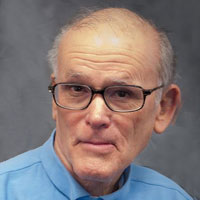 Joe McGuire — A member of the RESDC Board of Directors since December 2000, Joe retired from the Department of Public Works in 1999 after 38 years of County service. He also worked for the Planning Department in Building Inspection.
Joe McGuire — A member of the RESDC Board of Directors since December 2000, Joe retired from the Department of Public Works in 1999 after 38 years of County service. He also worked for the Planning Department in Building Inspection.
Joe was an elected member of the San Diego County Employees Retirement Association (SDCERA) Board for seven years. He studied Civil Engineering at New Mexico State University and received a Bachelor’s Degree in Public Administration from San Diego State University.
His enjoyable retiree activities include volunteerism with RESDC, as well as serving on the Endowment Committee for the University City United Church for Christ. Joe’s favorite travel adventures include a Panama Canal transit cruise, as well as cruises to Alaska, Mexico, Hawaii, and the St. Lawrence River. He also spent three weeks in London and three weeks in Ireland.
Joe has been married 53 years and has one child.
Pension Facts
Pension Facts at a Glance
15% or more
Percentage of personal income Americans should be saving for retirement, according to State Controller Betty Yee. Currently, the U.S. ranks 20th globally at 5+%.
Combating Distrust in Government with Public Service Stories
By Chris Heiserman, Director
This month I am writing about a special series of video interviews with individuals who are or were public employees proud of their work making a difference in American lives.
Most citizens today have little respect for their government. A 2015 Pew Research Center survey found that just 19% of the public feel they can trust the federal government always or most of the time. What can be done to change this pervasive anti-government sentiment, you ask? The College of Public Affairs at the University of Nebraska Omaha had a novel idea: why not have dedicated, successful public servants tell their career stories in their own words on videotape?
Put human faces on the faceless bureaucracy and show everyone, especially perhaps young middle school, high school, and college students, that a government career choice could be noble and inspiring. The project is “Ask Me Why I Care – Public Service Stories.” It is a collection of 23 short videos by public employees who care deeply about their work and the positive impacts they have on the lives of the Americans they serve. The videos focus on four major areas of government service: Budget and Financial Management, Health and Human Services, Transportation and Emergency Services, and Public Safety.
Here are a few examples of the storytellers:
- Troy Jellison, a fire captain/EMT with the El Dorado, Kansas Fire Department. He’s been with the department 14 years, but started his career as a volunteer for a small rural department after his junior year in high school. He loves serving his community and says, “It is a very gratifying job.”
- Selvi Stanislaus is Executive Officer of the California Franchise Tax Board, the second largest tax department in the nation. She is a native of Sri Lanka who immigrated to California in 1986. She has greatly improved the department’s transparency and customer service, and expanded its use of electronic services. She strongly supports continuing education and community service among her 6,000 employees. She advocates “…learning as much as you can wherever you are…”
- Edward A Flynn has been police chief in Milwaukee, Wisconsin since 2008, but served as police commissioner in Springfield, Massachusetts from 2006-2008. In Massachusetts, he served as chief advisor to the Governor on Homeland Security. He has some interesting observations about the need for regional cooperation among the vast array of local law enforcement agencies to meet the threat of terrorism in this country.
- Brandy Hodge was volunteer services coordinator for the Department of Human Services in Johnson County, Kansas when she was interviewed in 2014. Her program services residents who are vulnerable due to restricted incomes, aging issues, or disabilities. She is passionate about the value of the assistance provided by the hundreds of volunteers she trains and sends out to help people in need. She said, “It’s not just all the red tape and bureaucracy that a lot of people think about…there is so much more of a caring nature to government.”
The sponsors of this project at the University of Nebraska Omaha felt that the power of “real life” stories had the best chance of changing attitudes about government workers. They believed that asking public servants to tell their stories honored them and their commitment to their work. The videos tell inspiring stories of caring individuals who deliver valuable services that matter to so many. Take a look at some of these compelling personal videos at:
http://www.unomaha.edu/college-of-public-affairs-and-community-service/community-engagement/public-service-stories.php
Maybe we should make it possible for some of our RESDC members to share their public service stories?
Flag Day Luncheon 2016
General Membership Meeting
Thursday, June 16, 11:00am
New Location!
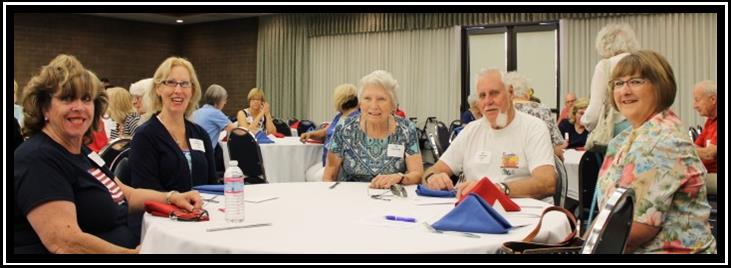
Don’t miss the fun at the 2016 Flag Day Luncheon!
RESDC’s Flag Day Luncheon is scheduled for Thursday, June 16th at a new location this year! The luncheon will be held at the La Mesa Community Center in MacArthur Park, 4975 Memorial Dr., La Mesa, 91942. This year we pay tribute to our military with a music program, sung by Christian Youth Theater San Diego Performance Group. Be sure to get your reservation mailed in early! The cost of the Flag Day Luncheon is $12 per person.
What: Lunch—$12.00 per person
When: Thursday, June 16, 2016, 11:00 a.m.
Where: La Mesa Community Center in MacArthur Park
4975 Memorial Dr., La Mesa, CA 91942
Parking Map | Google Maps
Entertainment By: Christian Youth Theater San Diego Performance Group. Students will sing a tribute to our military.
Menu: Ham, Roast Turkey, salads, fruits, vegetables, desserts, coffee or tea.
To Attend: Please complete the Reservation Form, include the name of person(s) attending, and send a check for $12.00 per person, payable to RESDC at 8825 Aero Dr., Suite 205, San Diego, CA 92123. Reservation forms must be received in the RESDC office by Friday, June 10. Tickets should be picked up at the registration table at the luncheon. They will not be mailed. Parking is adjacent to the Community Center with overflow parking available in three other lots at the center. The closest overflow parking lot is the Cottage lot and it will be well marked.
Want to print this information? Click here for a PDF flyer with event details and parking map.
28th Annual Southern California Public Retirement Seminar
March 24, 2016
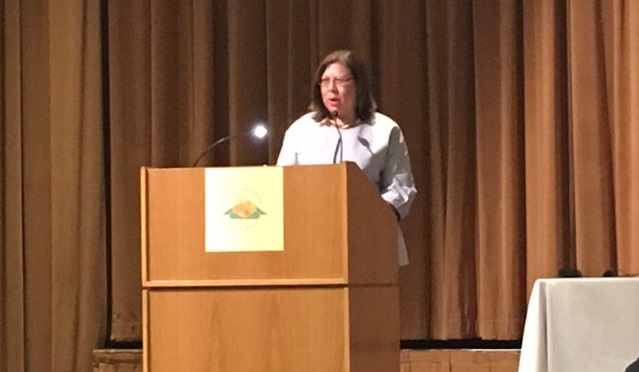
California State Controller Betty Yee delivered the keynote address at the 28th Annual Southern California Public Retirement Seminar.
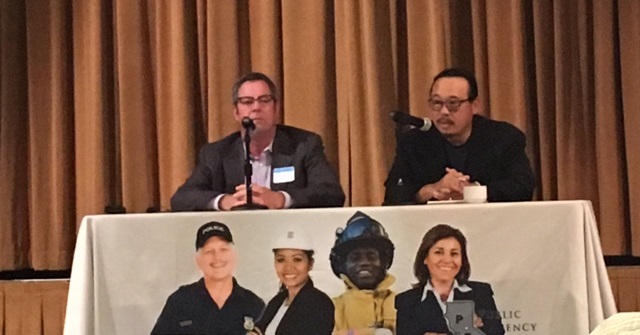
Terry Brennard, SEIU, and Dave Low, Californians for Retirement Security, discussed labor’s perspective on recent attacks on public pensions at the Annual Public Retirement Seminar.
San Diego County Credit Union

Summer is right around the corner and it’s not too late to start saving for your next vacation. San Diego County Credit Union’s products and services make saving easier than ever. It could be as simple as setting up a new savings account, using our 30,000 surcharge-FREE CO-OP ATMs, refinancing to a lower interest rate or saving money on postage by paying your bills online.
Start saving for your goals today. Visit sdccu.com, call (877) 732-2848 or come into any of our convenient branch locations.
Welcome New Members
Cathy M. Cogan – Health & Human Services
Walter Ekard – Chief Administrative Office
Lisa Hecker – Health & Human Services
Dona Hollingsworth – Sheriff
Gwendolyn Lewis-Parker – Probation
Jean Myers
Karen M. Penniman
Shannon Tennen – Social Service
In Memoriam
Marwan I. Arikat* – Health & Human Services
Kathleen Brown – Sheriff
Janice Broze – Surviving Spouse
P. Ruth Bryce – Probation
Alfred Burroughs Jr. – Sheriff
Ruth Eddy – Surviving Spouse
Martha Eitel – Surviving Spouse
Agustin Fernandez – Sheriff
Barbara Gerrard – Public Defender
Betty Gibson – Surviving Spouse
James Grimm – Sheriff
Adiela Gutierrez – Auditor & Controller
John Halstead – Probation
Lillian Hamilton
Richard Hanscom – District Attorney
Rodney Hickman – General Services
Alan Landers – Purchasing & Contracting
Anita Manary – General Services
Angela Manuel – Health & Human Services
Richard McCaig – Sheriff
Colleen McClintick – District Attorney
William Newton – Information Technology
Julie A. Obana* – Sheriff
Sharon Olsen – Social Services
Beatrice J. Pearson – Surviving Spouse
Helen Pfister – Superior Court
Olga W. Puhn – Welfare
John Pieri – Social Services
Walter E. Price Jr. – Welfare
Marjorie Ross – Probation
Leticia San Pedro – Superior Court
Sadie Thomas – Welfare
Leonard Thursby – Social Services
Josephine Valenzuela – Registrar of Voters
Mary J. Webb – Surviving Spouse
Donna R. West – Surviving Spouse
Thomas E. Whitson – Planning & Land Use
Wallace N. Willoughby – Sheriff
*Active
As long as we think of you,
You’ll always be with us.
The surviving spouse of a member is eligible for RESDC membership. For enrollment assistance, call (619) 688-9229.
Member Privacy
Any retiree or surviving spouse who does not want his/her death notice published in the “In Memoriam” section of this newsletter may notify the RESDC office and your privacy will be maintained.
NETWORK is the official monthly newsletter of the Retired Employees of San Diego County, Inc. (RESDC), a private non-profit organization.
The information printed in the NETWORK is believed to be from reliable sources. However, no responsibility is assumed by the NETWORK for inaccuracies contained herein.
Business and Inquiries: Business matters and address changes may be recorded on our voicemail at any time, call (866) 688-9229. Please spell your name so the correct member record can be located.
Retired Employees of San Diego County, Inc.
8825 Aero Drive, Suite 205 | San Diego, CA 92123
Office Hours: 9 a.m. to 2 p.m. Monday through Friday
TELEPHONE: (866) 688-9229 Toll Free
FAX: (619) 688-0766
E-MAIL: resdc@resdc.net



